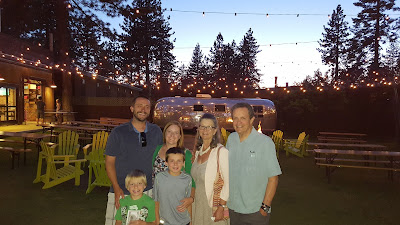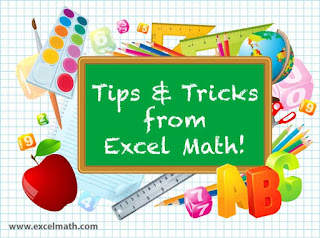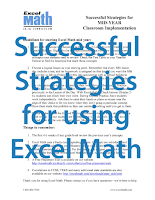 |
| Lake Tahoe with the family |
It's National Take a Hike Day, celebrated each year on November 17. And since this is also the 100th year celebration of our National Parks, hiking is a wonderful way to join the celebration and simultaneously explore some of the spectacular outdoor places our country has to offer.
This photo was taken at Lake Tahoe, where the Baker family enjoyed a camping trip filled with water sports, hiking, and enjoying the great outdoors.
 |
| Big Pine Lake hiking |
Big Pine Lake is another beautiful place to hike in California, and now that we have some cooler weather (at times), hiking can be a fun way to see the fall colors and shuffle through the leaves.
The scent of pine brings memories of holidays and anticipating fun times with family and friends.
At
Excel Math, we include word problems to help students tackle real-world problems. Here's a word problem from our Grade 3 Student Lesson Sheets:
Mr. Park went on a hike. He saw 8 deer.
That was 7 fewer than the number of
rabbits he saw. He saw 3 more hawks
than rabbits. How many hawks did he see?
Excel Math lessons merge math with literacy in our
Create A Problem exercises. These in-depth story problems give students an opportunity to use higher-level thinking skills and begin to write and solve their own word problems as their math skills progress. Take a look at sample
Create A Problems for Grades 2-6.
 |
| Cowles Mountain Summit |
Here's a photo of the summit of Cowles Mountain in San Diego, a very popular hiking spot for residents and visitors alike.
You can catch just a small glimpse of the 360º views from this photo. On a clear day you can see all the way to the Coronado Islands in Mexico.
Read more about Cowles Mountain and the various hiking trails in our blog posts from several years ago:
Take a Hike, Part 1 and then get out and walk your neighborhood.
Be sure to stop by the Mission Trails Visitors' Center just down the road to see local artwork and the interactive exhibits that explain the native culture as well as the plants and animals you may encounter on your hike.
 |
| Mission San Luis Rey Rose Garden |
Find a friend and try a new neck of the woods to explore on foot. Use the comments box below to let us know some of your favorite hiking spots.
If you prefer a less strenuous stroll, the Mission San Luis Rey in Oceanside has some beautiful gardens, complete with benches that offer a place to rest and smell the aroma of roses.
Certain times of year they also have rooms available for travelers to stay, providing a quiet respite away from the hectic pace of day to day activities and stress.
 |
| Huntington Beach |
Traveling around the diverse state of California, there are beaches around every corner along the coast.
Here's a picturesque view of Huntington Beach, where families gather for a meal after a busy day in the water. In the evenings, dinner is followed by s'mores around the fire pits after the sun has set.
Walking or jogging along the beach with the warm wind at your back can be a completely different experience a few weeks later when you walk that same beach in the midst of a downpour. Both are wonderful experiences!
 |
| Sunset at Torrey Pines State Park |
A cold, brisk day at the beach when the crowds have stayed home is a great opportunity to walk along the sand and enjoy the restless waves, the sea spray, and the solitude.
Sunsets over the water give a totally new perspective to the same beach that may have been crowded and noisy in the bright light of daytime, just a few hours earlier.
This photo was taken at Torrey Pines State Park.
The many hiking trails above the beach give families a chance to see some of the habitat native to Southern California up close and personal.
 |
| Torrey Pines State Beach |
Many of the plants and trees are labeled. Be sure to wear comfortable shoes instead of flip-flops.
Many of the paths and steps take you from the beach up to the scenic views shown in these photos.
Take a Hike Day gives you a great excuse to get outdoors and explore the beautiful areas of your own city and state.
But really, no excuse is needed to walk your neighborhood, your hiking trails, and learn about the history of the place you call home. Every day can be a wonderful time to take a hike!
 Arthur Wynne, a journalist from Liverpool, is credited for creating the first known published crossword puzzle. It appeared in the December 21, 1913 Sunday edition of the New York World newspaper. Solving crosswords quickly became a favorite pastime. Within a decade crossword puzzles appeared in almost all American newspapers.
Arthur Wynne, a journalist from Liverpool, is credited for creating the first known published crossword puzzle. It appeared in the December 21, 1913 Sunday edition of the New York World newspaper. Solving crosswords quickly became a favorite pastime. Within a decade crossword puzzles appeared in almost all American newspapers. 


















































